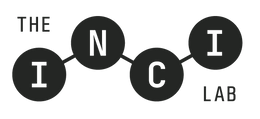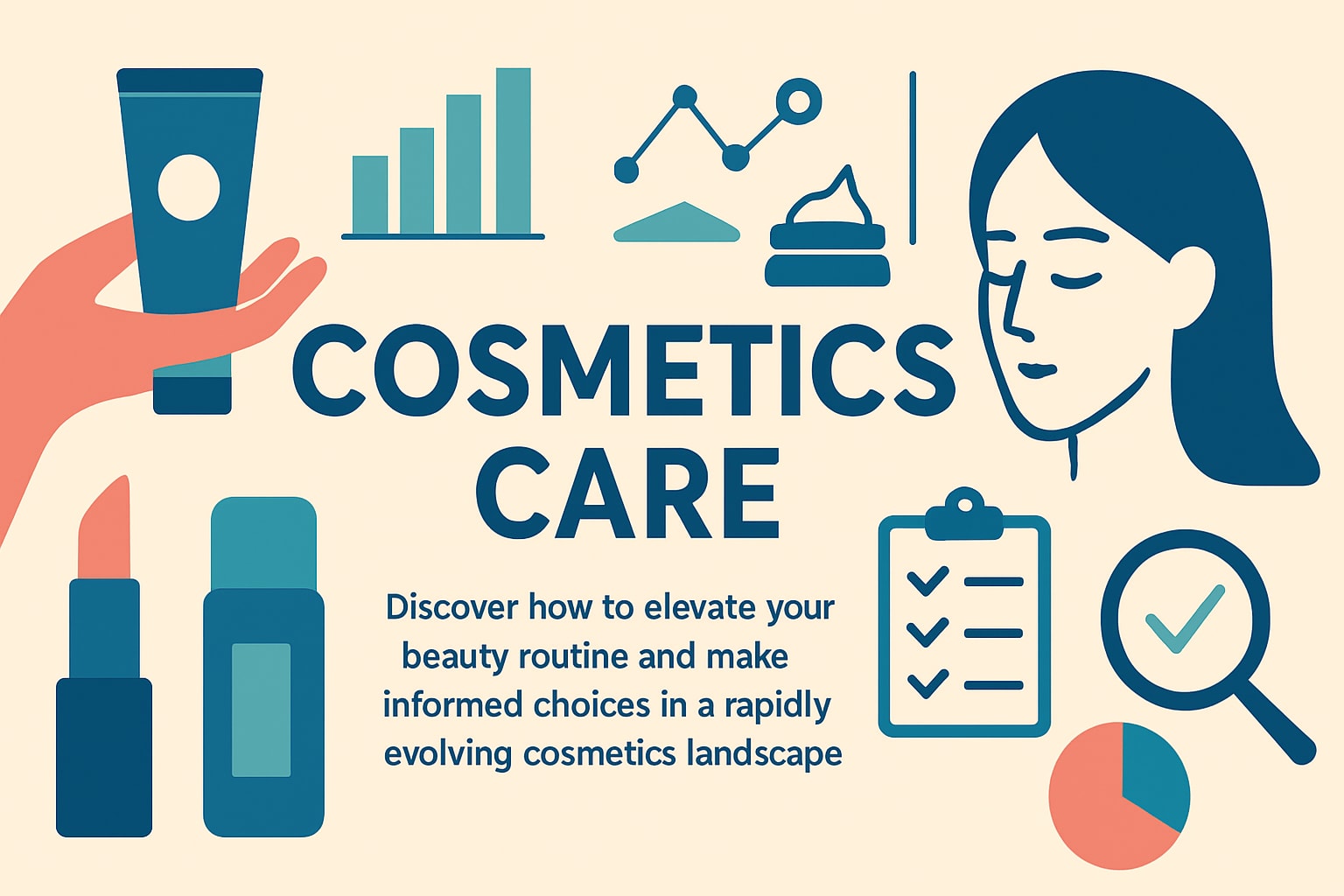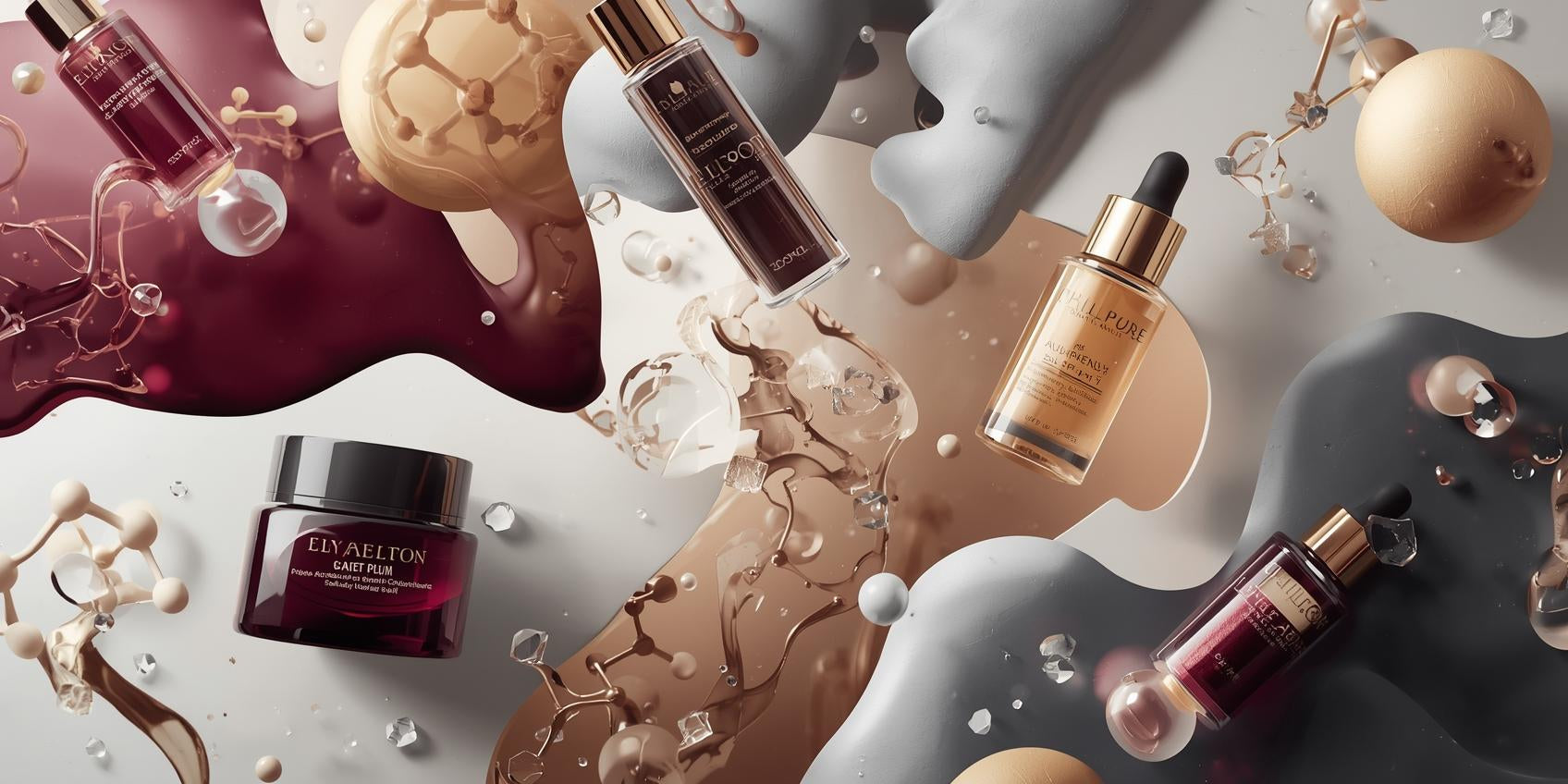Ever wondered how to start a cosmetics lab from scratch in 2025? Now is the perfect time. The global cosmetics market is booming and is set to reach $463.5 billion by 2027. Consumers are seeking innovative, eco-friendly products, opening exciting doors for new brands.
Entrepreneurs and small businesses have more opportunities than ever to stand out with unique formulations. This guide offers a clear, step-by-step roadmap to launching your own cosmetics lab, covering equipment, safety, formulation, compliance, and scaling up.
Follow along to gain the confidence and knowledge needed for a successful cosmetics lab journey. Here, you will find everything you need, from setup to future industry trends.
Step 1: Planning Your Cosmetics Lab
Launching a cosmetics lab begins with a solid plan that transforms your vision into a viable business. Careful planning ensures you identify your niche, set realistic goals, and build a foundation for lasting success. Whether you dream of crafting skincare or haircare products, this step will help you move from inspiration to a clear, actionable roadmap.
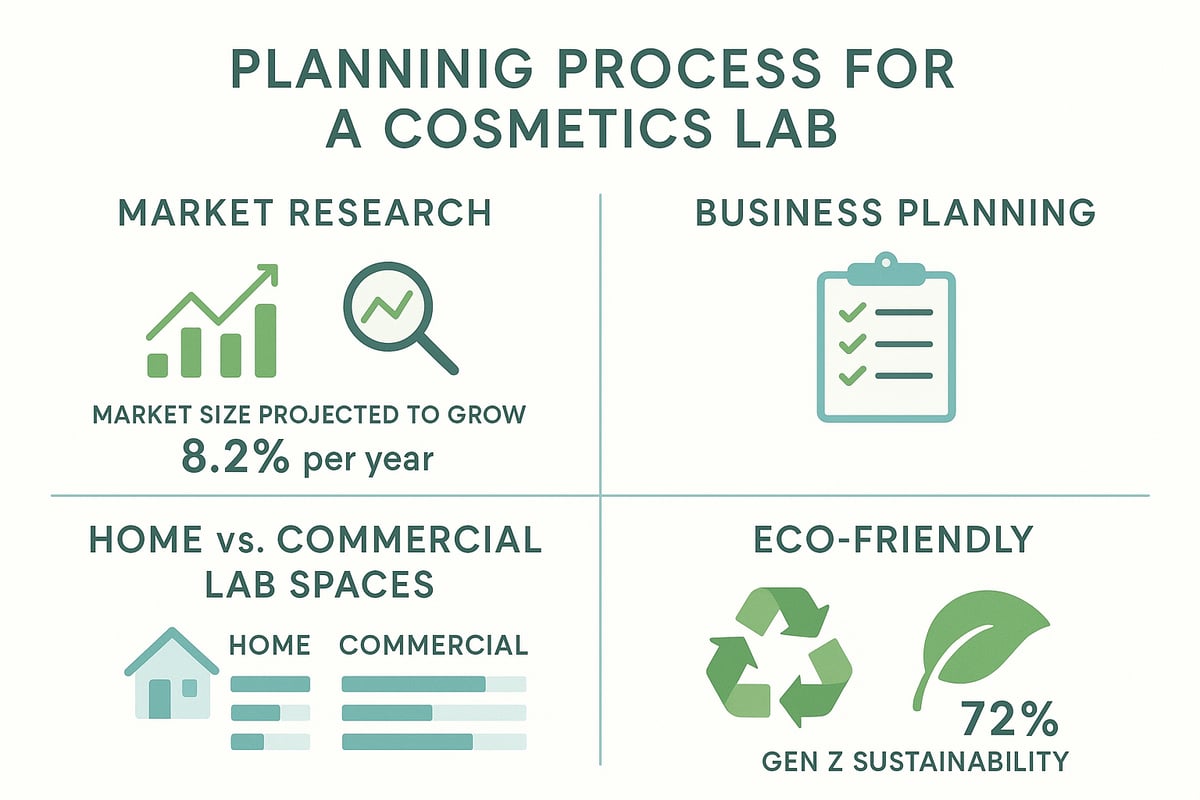
Understanding Your Vision and Market Niche
Start by defining what makes your cosmetics lab unique. Identify your mission, the audience you want to reach, and the products you plan to create, such as serums, cleansers, or hair treatments.
Research the competitive landscape and look for market gaps. For example, the surge in vegan beauty and sustainable products has opened doors for new brands. Trending ingredients like niacinamide and bakuchiol are in high demand, as are eco-friendly and cruelty-free options.
Set clear goals and timelines for your lab's launch. Consider that 73% of Gen Z consumers prefer brands with sustainability commitments (Statista, 2023). To understand the scale of the opportunity, the global cosmetics market is projected to reach $556.21 billion by 2032, reflecting a growing space for innovative new labs.
Budgeting and Business Planning
A successful cosmetics lab requires careful budgeting. Estimate your startup costs, including facility rental or setup, essential equipment, ingredients, and compliance expenses. Typical costs range from $5,000 for a basic home lab to $50,000 or more for a commercial operation.
Draft a detailed business plan that covers funding sources, pricing strategies, and your growth roadmap. Remember to factor in insurance and a contingency fund for unexpected expenses.
| Lab Type | Startup Cost | Space Needed | Pros | Cons |
|---|---|---|---|---|
| Home-based Lab | $5,000–$15,000 | 100–200 sq. ft. | Lower cost, flexible hours | Limited scalability, zoning |
| Commercial Lab | $20,000–$50,000+ | 300+ sq. ft. | Professional image, scalable | Higher cost, more regulation |
Compare the benefits and challenges of each model to choose the best path for your cosmetics lab.
Choosing a Suitable Location
Selecting the right location is crucial for your cosmetics lab. Assess your space needs, focusing on ventilation, natural and artificial lighting, secure storage, and logical workflow.
Home labs often start in a dedicated room of 100–200 square feet, providing flexibility and cost savings. Commercial spaces offer scalability and professional appeal but come with higher costs and stricter regulations.
Check local zoning laws to ensure your chosen location complies with business and safety requirements. Reliable utilities, including water, electricity, and waste disposal, are essential for smooth operations in any cosmetics lab.
Sustainability and Eco-Friendly Practices
Modern consumers expect sustainability from every cosmetics lab. Plan for energy-efficient equipment and systems to minimize waste. Choose biodegradable or recyclable packaging and source cruelty-free, ethically produced ingredients.
Consider these eco-friendly steps for your operation:
- Use renewable energy where possible
- Opt for minimal, recyclable packaging
- Prioritize suppliers with sustainable certifications
- Implement a waste reduction and recycling program
Consumer demand is clear: 65% of buyers prefer eco-friendly packaging (Mintel, 2023). Embedding sustainability into your cosmetics lab from the start will help you meet market expectations and build a stronger brand.
Step 2: Setting Up Your Lab: Equipment & Materials
Embarking on your cosmetics lab journey begins with assembling the right tools, sourcing pure ingredients, and adopting best practices for safety and efficiency. Each step you take now lays the foundation for quality, compliance, and future growth. Let’s break down the essentials for your 2025 setup.
Essential Lab Equipment for Beginners
Setting up a cosmetics lab requires a core set of reliable equipment to ensure accuracy and reproducibility. Start with a digital scale offering 0.01g precision, as precise measurements are vital for consistent results. Mixers, such as magnetic stirrers or hand-held blenders, help blend ingredients smoothly, while hot plates allow for controlled heating during formulation.
Other essentials include glass beakers, graduated cylinders, thermometers, and pH meters. These tools enable you to measure, mix, and monitor your creations with confidence. Prioritize equipment that is easy to clean and resistant to corrosion, as this maintains hygiene and product integrity in your cosmetics lab.
| Equipment | Purpose | Safety Tip |
|---|---|---|
| Digital Scale | Precise ingredient weighing | Calibrate regularly |
| Mixer/Stirrer | Homogenizing formulations | Secure cords, clean after use |
| Hot Plate | Controlled heating | Use heat-resistant gloves |
| Beakers/Cylinders | Mixing and measuring liquids | Handle glassware carefully |
| Thermometer | Monitor temperature | Store safely, avoid breakage |
| pH Meter | Test product acidity/alkalinity | Calibrate before use |
Sourcing Ingredients and Raw Materials
Quality ingredients are the backbone of every cosmetics lab. Seek out reputable suppliers who provide documentation for ingredient traceability and safety data. Look for certifications like COSMOS or Ecocert, which guarantee that raw materials meet strict standards for purity and ethical sourcing.
For example, shea butter from fair-trade cooperatives not only supports communities but ensures a transparent supply chain. Prioritize active ingredients, oils, butters, and preservatives with clear origin and batch information. This attention to sourcing builds trust and supports sustainability goals in your cosmetics lab.
When evaluating suppliers, check for:
- Certificates of analysis (COA)
- Allergen and contaminant testing
- Responsiveness to documentation requests
Lab Safety and Hygiene Standards
Maintaining safety in your cosmetics lab is non-negotiable. Always wear PPE such as gloves, goggles, and lab coats to protect skin and eyes from potential hazards. Establish strict sanitation protocols, including cleaning surfaces, sterilizing tools, and managing spills immediately.
Keep Material Safety Data Sheets (MSDS) accessible for all chemicals and review them before use. Proper documentation not only safeguards your team but also supports regulatory compliance. According to Cosmetics Business, 40 percent of small labs face compliance issues due to incomplete safety records, so make documentation a regular habit in your cosmetics lab.
Best practices include:
- Daily surface disinfection
- Routine PPE inspection
- Immediate spill containment and cleanup
Storage and Inventory Management
Effective storage solutions are key to maintaining ingredient quality and preventing cross-contamination in your cosmetics lab. Use temperature-controlled cabinets for heat-sensitive items and flameproof storage for volatile solvents. Color-coded containers simplify organization and minimize mistakes.
Implement an inventory tracking system, either digital or manual, to monitor stock levels and expiration dates. Clearly label all ingredients with batch numbers and shelf lives. This approach not only streamlines workflow but also ensures traceability if you ever need to track a batch in your cosmetics lab.
Tips for efficient storage:
- Store actives away from direct sunlight
- Use airtight jars for powders and clays
- Separate raw materials from finished products
Budget-Friendly Lab Setup Tips
Launching a cosmetics lab does not have to break the bank. Starter kits bundle essential tools at a lower cost, making them ideal for beginners. Consider sourcing second-hand equipment from laboratory suppliers or business liquidations, provided the items meet safety standards.
DIY storage solutions, such as repurposed kitchen jars or shelving units, can save money without compromising functionality. Always prioritize safety and compliance, even when cutting costs. Careful budgeting and resourcefulness allow you to allocate funds toward high-impact areas in your cosmetics lab.
Cost-saving strategies:
- Buy in bulk for discounts
- Share equipment with local makerspaces
- Regularly review expenses and adjust as needed
The INCI Lab: Expert Support for Custom Formulations
For those seeking expert guidance, The INCI Lab offers comprehensive support tailored to new and growing cosmetics lab ventures. Their team specializes in award-winning custom formulations, ingredient sourcing, and regulatory advice, helping you avoid costly mistakes.
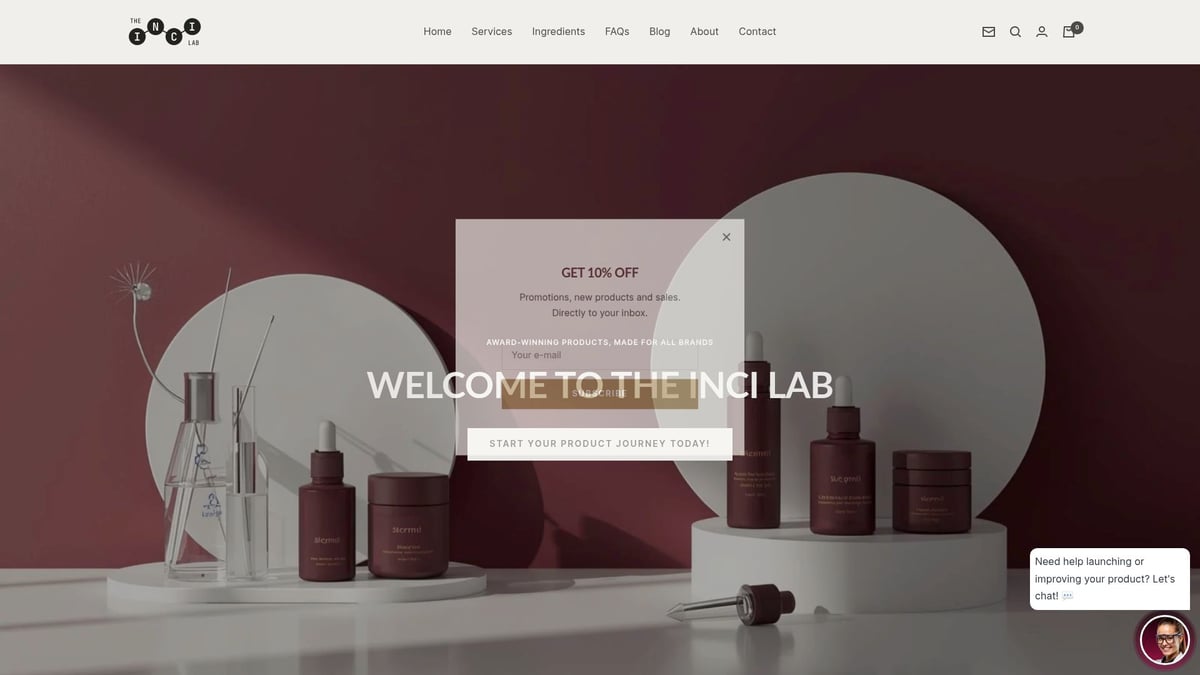
Clients retain full ownership of their formulas, ensuring long-term brand flexibility. The INCI Lab’s commitment to eco-friendly practices and scientific rigor makes them a trusted partner for both startups and established brands. With their help, you can accelerate product development and confidently launch innovative products from your cosmetics lab.
Step 3: Cosmetic Formulation Basics for Beginners
Entering the world of cosmetics lab formulation can seem daunting, but with the right knowledge and structure, you can confidently develop safe, effective products. Whether you are new or expanding your cosmetics lab, understanding the science and process is crucial.
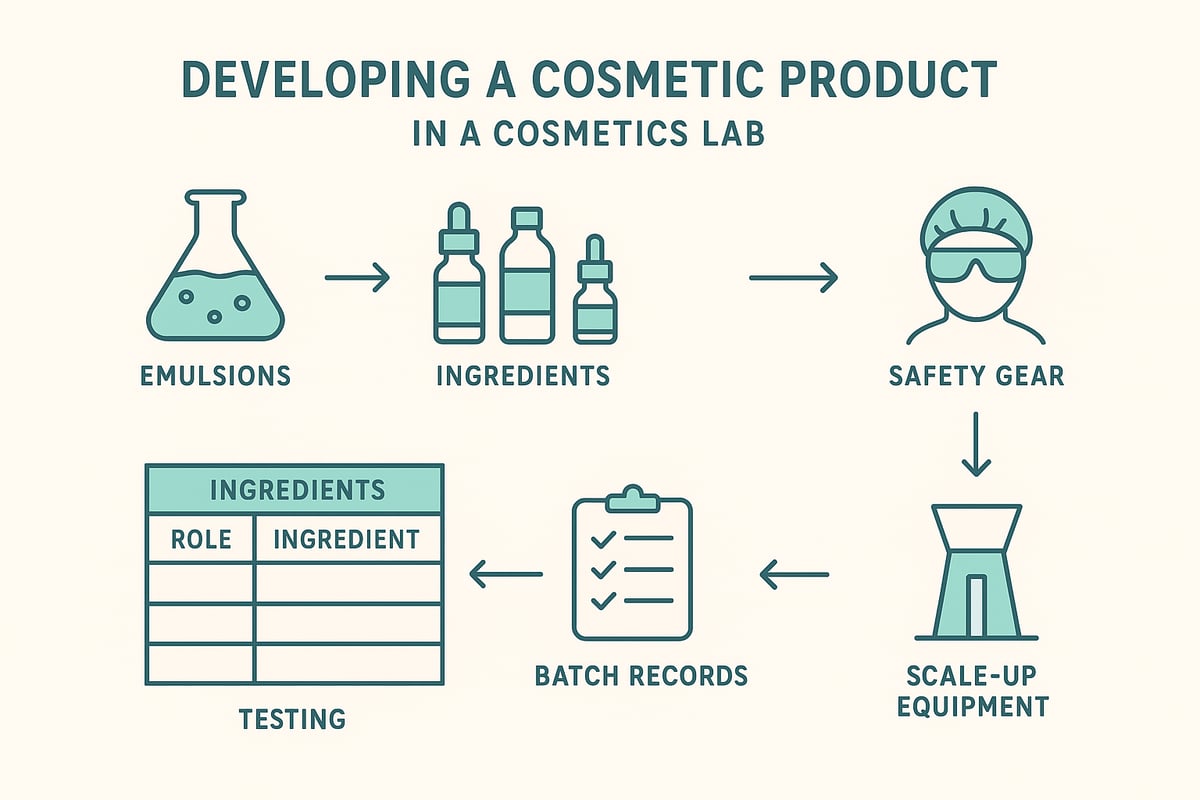
Understanding Cosmetic Science Fundamentals
At the heart of every cosmetics lab is a solid grasp of cosmetic science. Most formulations are either emulsions (oil and water blended with an emulsifier), suspensions (solid particles in a liquid), or solutions (ingredients fully dissolved).
Key ingredient roles include:
| Ingredient Type | Function | Example |
|---|---|---|
| Surfactant | Cleanses, foams | Sodium lauryl sulfate |
| Emollient | Softens skin | Shea butter |
| Humectant | Attracts moisture | Glycerin |
| Preservative | Prevents spoilage | Phenoxyethanol |
In your cosmetics lab, knowing how these components interact helps you create stable, high-performing products. Always consider the compatibility of your ingredients and the intended use.
Formulation Development Process
Developing a new product in your cosmetics lab involves several key steps. Start with ideation and research, identifying your unique product vision and target audience needs. Select ingredients based on function, safety, and market trends.
The typical process includes:
- Ingredient selection and weighing
- Bench formulation and mixing
- Small-batch testing for texture, efficacy, and safety
- Refinement based on results
- Stability and compatibility testing
For a detailed, practical walkthrough, review this Step-by-Step Cosmetic Product Formulation resource. Following a structured process streamlines product development and reduces costly errors in your cosmetics lab.
Record-Keeping and Batch Documentation
Accurate record-keeping is essential for every cosmetics lab. Maintain detailed lab notebooks and batch sheets to ensure traceability, repeatability, and regulatory compliance.
Essential data to record:
- Ingredient names and lot numbers
- Exact weights and measurements
- Step-by-step process notes
- Batch numbers and production dates
Implementing Good Manufacturing Practice (GMP) documentation in your cosmetics lab protects your formulations, supports quality control, and is often required by regulators.
Troubleshooting Common Formulation Issues
Even in a well-organized cosmetics lab, issues like separation, graininess, or microbial growth can occur. Addressing these problems promptly ensures product safety and customer satisfaction.
Common issues and solutions:
| Problem | Solution |
|---|---|
| Separation | Adjust emulsifier type or amount |
| Graininess | Control cooling rate, refine mixing |
| Microbial growth | Use effective preservative, sanitize equipment |
Regular testing and documentation in your cosmetics lab help you identify and resolve these issues efficiently.
Experimenting Safely with New Ingredients
Safety should always be a priority in your cosmetics lab, especially when introducing new ingredients. Start with patch testing on small skin areas to check for irritation. Review allergen data and adhere to recommended maximum usage rates for actives.
Follow these safety steps:
- Wear gloves, goggles, and lab coats
- Use accurate scales for dosing
- Research ingredient safety profiles
A cautious approach ensures your cosmetics lab produces products that are both innovative and safe for consumers.
Scaling from Test Batches to Production
Scaling up in your cosmetics lab means moving from test batches to larger production runs without compromising quality. Consistency is key. Adjust mixing speeds and heating times proportionally, and document every change.
Techniques for success:
- Gradually increase batch size, monitoring each stage
- Maintain identical ingredient ratios
- Perform stability and compatibility tests at each scale
By following these principles, your cosmetics lab can grow from small-batch innovation to reliable, market-ready production.
Step 4: Navigating Cosmetic Regulations & Compliance
Understanding and navigating cosmetic regulations is crucial for every cosmetics lab. Regulatory compliance is not just about ticking boxes; it safeguards your brand, your customers, and your business reputation. Whether you are formulating skincare or color cosmetics, each step must align with evolving global standards.
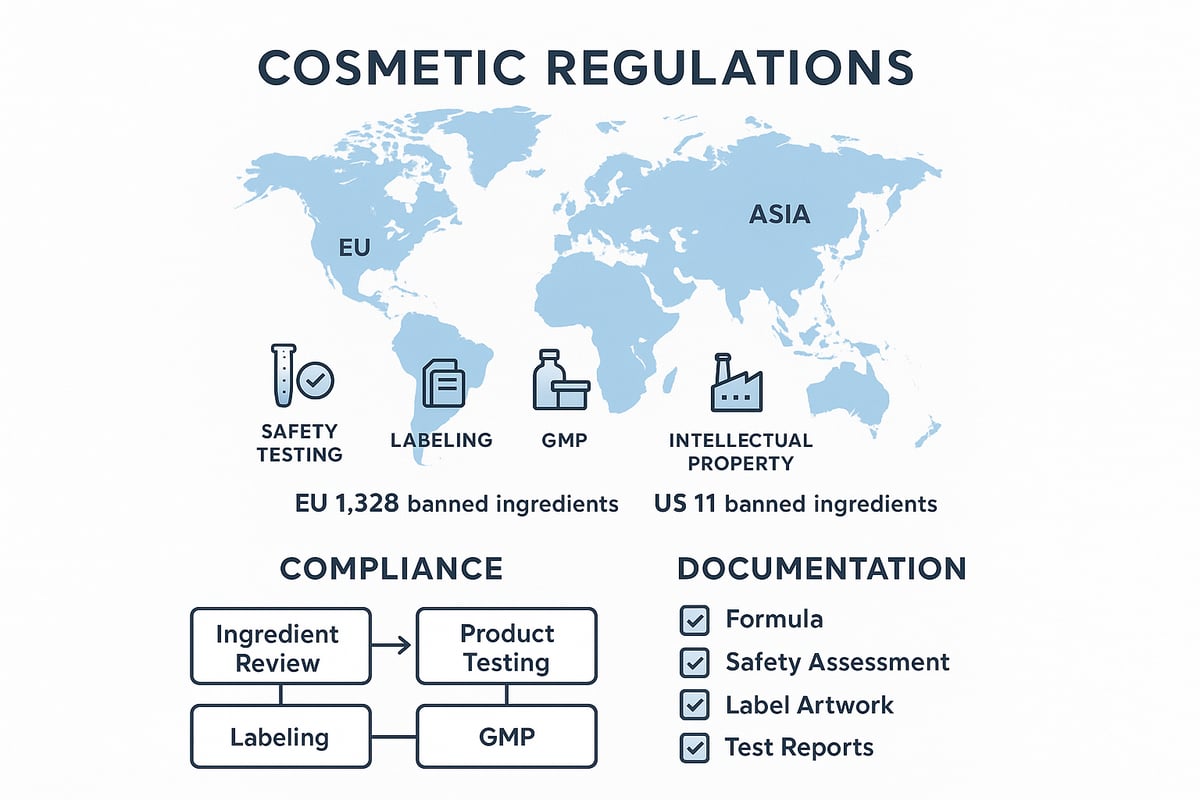
Overview of Global Cosmetic Regulations
Global regulatory frameworks for cosmetics labs vary significantly. The EU Cosmetics Regulation (EC) No 1223/2009 is among the strictest, banning over 1,300 substances and requiring comprehensive safety assessments. In contrast, the US FDA bans just 11 ingredients, focusing more on post-market surveillance.
Local authorities may impose additional rules. For example, Asian markets often require pre-market registration. Staying informed is essential, as regulations evolve quickly. For a deeper dive, see Understanding Cosmetic Regulations and Compliance, which explains why compliance is vital for any cosmetics lab.
Product Safety and Testing Requirements
Every cosmetics lab must ensure product safety before items reach the market. Mandatory tests include stability testing, which checks how your product holds up over time, challenge testing for preservative efficacy, and thorough microbial testing.
Patch testing on volunteers is recommended to check for irritation or allergic reactions. Without these protocols, a cosmetics lab risks recalls or legal action. Always document results, as regulators may request proof during inspections.
Labeling and Claims Compliance
Proper labeling is a non-negotiable aspect of running a cosmetics lab. All ingredients must be listed using INCI names, and labels should display batch numbers, expiration dates, and usage instructions.
Claims such as "natural," "organic," or "hypoallergenic" require evidence and must meet local standards. Mislabeling can lead to fines exceeding $10,000 in some regions. A cosmetics lab should review all labels regularly to avoid costly mistakes.
GMP (Good Manufacturing Practices) for Small Labs
Implementing GMP is essential for every cosmetics lab, regardless of size. Good practices include maintaining cleanrooms, documenting procedures, and establishing quality control checks.
The US FDA provides guidance even for home-based producers. By following GMP, a cosmetics lab minimizes contamination risks and ensures consistent product quality. Regular audits and training help maintain high standards.
Keeping Up with Regulatory Changes
Regulations for cosmetics labs change frequently. Staying updated requires monitoring trade associations, subscribing to regulatory newsletters, and consulting experts.
Online databases and regulatory consultants provide timely updates on ingredient restrictions and labeling laws. Being proactive helps a cosmetics lab remain compliant and avoid disruptions.
Intellectual Property and Formulation Ownership
Protecting your intellectual property is vital for every cosmetics lab. Use non-disclosure agreements (NDAs) with partners and consider patenting unique formulations.
Retaining control over your recipes ensures your business remains competitive. Industry best practices include clear documentation and formal agreements with collaborators.
Step 5: Scaling Up: From Lab Bench to Market
Scaling up your cosmetics lab from a creative workspace to a professional production environment is a pivotal step for any aspiring beauty entrepreneur. As you transition from small test batches to market-ready products, careful planning ensures your cosmetics lab can meet demand without compromising quality or compliance.
Small-Batch vs. Large-Scale Production
Choosing between in-house small-batch production and outsourcing to contract manufacturers is a critical decision for your cosmetics lab. Small-batch production offers control and flexibility, allowing you to refine formulas and respond quickly to customer feedback. However, it may limit your capacity as demand grows.
Contract manufacturing, by contrast, enables larger volumes and can streamline compliance. Yet, it often requires higher minimum orders and less direct oversight. Evaluate your cosmetics lab’s goals, available equipment, and desired growth pace when making this choice.
| Production Model | Pros | Cons |
|---|---|---|
| Small-Batch (In-House) | Full control, agile | Limited volume, labor-intensive |
| Contract Manufacturing | Scalable, professional QA | Higher MOQs, less oversight |
Packaging, Branding, and Marketing Essentials
Packaging plays a dual role: it protects your formulations and communicates your brand’s identity. Select packaging that maintains product stability and aligns with your values, such as recyclable or minimalist designs. Consistency in branding—color palette, logo, and messaging—sets your cosmetics lab apart in a crowded market.
Stay informed about international packaging standards, as compliance is vital for market access. Refer to ISO 22715:2006 Cosmetics — Packaging and labelling to ensure your packaging meets global requirements and builds consumer trust.
Creating a compelling story around your cosmetics lab and using eye-catching visuals can boost your marketing efforts, both online and in-store.
Distribution Channels and Sales Strategies
Expanding your cosmetics lab’s reach requires a multi-channel approach. Direct-to-consumer e-commerce platforms provide control over branding and customer interaction. Retail partnerships and marketplaces offer access to larger audiences but may involve stricter requirements and commission fees.
Consider logistics early on. Proper inventory management, reliable shipping partners, and clear return policies help your cosmetics lab maintain customer satisfaction and minimize disruptions.
Quality Assurance and Customer Feedback
Quality assurance is essential as your cosmetics lab grows. Implement batch tracking, document every lot, and establish recall procedures to address potential issues promptly. Encourage customer feedback to identify areas for improvement and build brand loyalty.
Leverage reviews and testimonials to refine your products and reinforce trust. Transparent communication about your cosmetics lab’s quality standards fosters long-term relationships with your audience.
Funding and Business Growth
Scaling a cosmetics lab often requires additional funding. Explore grants, small business loans, and crowdfunding platforms like Kickstarter. Many indie beauty brands have successfully raised over $50,000 through well-crafted campaigns that highlight unique formulations or sustainable practices.
Prepare detailed financial projections and growth plans to attract investors. Maintaining a strong business foundation will help your cosmetics lab navigate the challenges of expansion.
Building a Sustainable, Compliant Operation
As your cosmetics lab scales, ongoing training and regular process audits keep operations efficient and compliant. Adopting international standards like ISO 22716 for good manufacturing practices ensures product safety and quality, which is crucial for earning customer trust and meeting regulatory requirements.
Invest in continuous improvement—review procedures, update documentation, and stay informed about industry trends. With a commitment to sustainability and compliance, your cosmetics lab can achieve long-term success in the evolving beauty marketplace.
Step 6: Future Trends & Innovations in Cosmetics Labs
The cosmetics lab landscape is evolving rapidly. New trends, technologies, and consumer demands are reshaping how products are formulated, produced, and brought to market. Staying ahead means embracing innovation and keeping an eye on the future.
Clean Beauty and Ingredient Transparency
Consumers are demanding more transparency from every cosmetics lab. Ingredient lists must be clear, concise, and easy to understand. The popularity of “free from” claims and full disclosure is driving brands to reformulate and rethink labeling.
Programs like “Clean at Sephora” have set new standards, influencing global brands to adopt stricter ingredient policies. According to a premium cosmetics market report, demand for clean and eco-friendly premium beauty products is surging, indicating a clear shift in consumer priorities.
Advances in Sustainable and Green Chemistry
Sustainability has become central to every modern cosmetics lab. Green chemistry innovations are enabling the creation of biodegradable ingredients, waterless formulations, and products that minimize environmental impact.
For example, solid shampoo bars are reducing plastic waste and water consumption. Brands are investing in renewable sourcing and closed-loop manufacturing, responding to both regulatory and consumer pressures for greener operations.
Personalization and AI-Driven Formulation
Personalization is transforming the cosmetics lab experience. AI tools now help predict product stability, optimize ingredient interactions, and even tailor formulations to individual skin types or genetic profiles.
Custom skincare, leveraging microbiome data, is becoming more accessible. These advances empower brands to offer unique, data-driven products that deliver real results and foster stronger customer loyalty.
Biotechnology and Lab-Grown Ingredients
Biotechnology is opening new frontiers for cosmetics lab innovation. Fermentation and cellular agriculture techniques are producing high-performance actives, such as lab-grown collagen, with unmatched purity and consistency.
This emerging segment is projected to reach $1.5 billion by 2027, offering sustainable alternatives to traditional animal- or plant-derived ingredients. Biotech is also reducing supply chain risks and supporting ethical sourcing initiatives.
Regulatory Technology (RegTech) for Compliance
Regulatory compliance is increasingly complex for any cosmetics lab. RegTech solutions—digital tools for real-time ingredient screening, documentation, and compliance monitoring—are streamlining operations.
Automated systems help brands keep pace with evolving global regulations, prevent costly errors, and maintain consumer trust. These technologies are now essential for both startups and established players.
The Rise of Indie and Niche Brands
Indie brands are driving innovation in the cosmetics lab sector. Agile, creative, and closely attuned to consumer trends, they now account for a significant share of new product launches.
In 2023, 25 percent of new skincare launches came from indie brands, showcasing the power of small, focused teams to disrupt legacy players. Niche positioning and direct consumer relationships are key to their rapid growth.
Globalization and Cross-Border Opportunities
Expanding internationally is more attainable for cosmetics lab entrepreneurs than ever before. Brands are navigating complex export regulations, securing international certifications, and leveraging digital marketplaces to reach global audiences.
Strategic partnerships and knowledge of local markets are crucial for success. Cross-border e-commerce and regulatory harmonization are unlocking new growth opportunities worldwide.
Continuous Learning and Industry Resources
Continuous education is vital for anyone operating a cosmetics lab. Networking, online courses, and trade shows like in-cosmetics Global keep professionals informed and competitive.
Organizations such as the Society of Cosmetic Chemists offer valuable resources, while 2025 Beauty Industry Trends reports provide actionable insights into emerging innovations and market dynamics.
You’ve just explored the essential steps to launch your own cosmetics lab—from finding your niche and building a sustainable setup to navigating regulations and staying ahead of industry trends. Whether you’re dreaming up your first product or ready to scale, having expert guidance and practical resources can make all the difference. To help you take the next step with confidence, I recommend you Download Your Free E-Book. It’s packed with actionable insights and tools to turn your cosmetic brand vision into reality.
